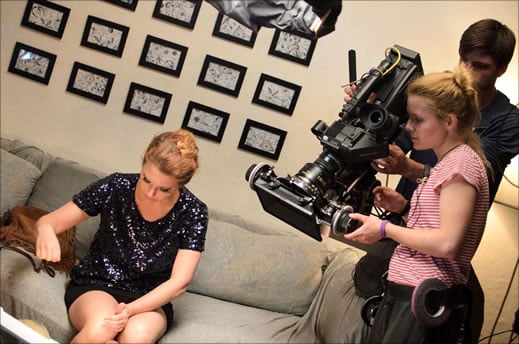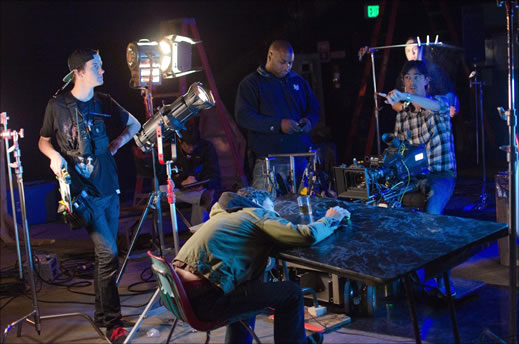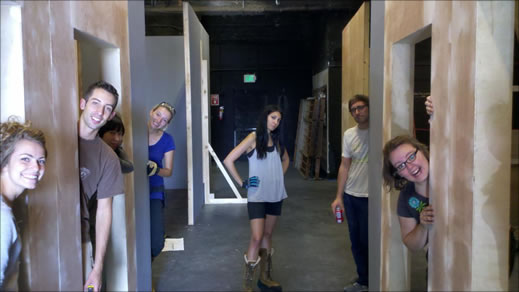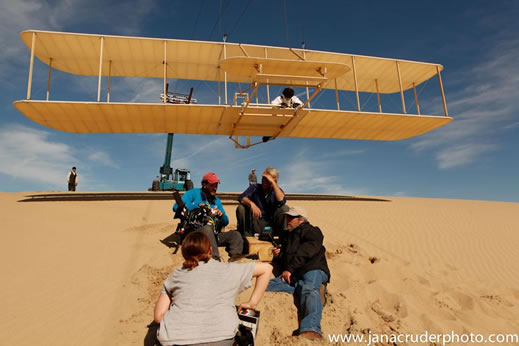On Campus News
| AFI Conservatory Discusses Production Design Program: Top Skills Needed for Today's Production Designers By Camille Haimet, StudentFilmmakers Magazine posted Jul 5, 2013, 20:33 |

Photo courtesy of AFI Conservatory.
What's new at AFI Conservatory?
AFI Conservatory: We are very excited to announce a significant increase in scholarship funds for First Year Fellows at the AFI Conservatory in 2013 and beyond.
The AFI Conservatory has just named James L. Brooks -- the producer of The Simpsons and The Mary Tyler Moore Show, mentor of Cameron Crowe and Wes Anderson and triple Oscar winner for directing, writing and producing Terms of Endearment -- as the new artistic director.
Tell us more about your Production Design degree program. What's new with the program?
AFI Conservatory: AFI's Production Design curriculum focuses on the creative process of visually and physically developing an environment that becomes an essential component of the storytelling process. We attract artists from architecture, interior design, scenic design, theater arts and other related fields.
We just hosted our Production Design Showcase at our on-campus soundstage, featuring work from First and Second Year Production Design Fellows where they exhibit their work in a gallery setting to invited leaders of the professional design community.
Are you currently accepting applications for the Production Design program?
AFI Conservatory: We're currently accepting applications for the 2013-2014 academic year for Production Design. Please visit AFI.edu for more information.
Established in 1969, the two-year Master of Fine Arts program provides training in six filmmaking disciplines: Cinematography, Directing, Editing, Producing, Production Design and Screenwriting. Mirroring a professional production environment, Fellows collaborate to make more films than any other graduate level program. Admission to AFI Conservatory is highly selective, with a maximum of only 140 graduates per year. Graduates finish with either a Master of Fine Arts degree or Certificate of Completion.

Photo courtesy of AFI Conservatory.
In your own words, could you talk a little about, "What is Production Design?" and what are the most important qualities that make a great Production Designer?
AFI Conservatory: Production Design is the art and craft of turning a written story into a visual one through found and built Architectural spaces that are decorated, aged and transformed based on character back story and core story themes explored. Production Design helps to create a story's mood with believable spaces that visually supports the script and director's intent.
A Production Designer should be a great storyteller, collaborator and a problem solver that can survive the challenges of last minute schedule changes. He or she has to be able to strike a balance between creative artist and businessperson. In Entertainment, logical thinking does not always rule the day, and a Production Designer who wants a lasting career must be able find peace with that.
What are some of the important top key skills needed for today's Production Designers?
AFI Conservatory: Today's Production Designer has a bevy of tools at his/her disposal to bring a creative idea from inception to paper. Every film and TV project is an original story set in a unique place and a different time period, so a Production Designer must love to research. A good designer should also love to sketch to be able to quickly get their ideas on paper for the director.
In this digital age, the new generation of film and TV designers should master the following skills in both traditional and digital approaches: Drafting, Model Making, Perspective Drawing, Illustrating and Graphic Design. In addition, computer programs such as SketchUp, Vectorworks, Photoshop, Illustrator, Rhino and Maya are used in most art departments.
Do your students have the opportunity to work on student productions as production designers at AFI?
AFI Conservatory: At the AFI Conservatory, our Production Design Fellows are required to Production Design three "Cycle" films and assist or art direct on another three "Cycle" films in their first year (6 projects in total). A "Cycle" film is a 20 minute short film made in four days (Cycle 1) or 3 days (Cycles 2 & 3). In their 2nd year, Fellows must design one Thesis film (a project with a larger budget that, once completed, can enter the film festival circuit). These production projects are happening in conjunction with classes and class assignments, so Fellows learn solid time management skills.

Photo courtesy of AFI Conservatory.
In your own words, what would you say are the top benefits of the Production Design program for students?
AFI Conservatory: Many of our Design Fellows find themselves surrounded for the first time by other filmmakers and artists that are as passionate about telling stories through the camera lens as they are. They feel they have moved closer to their professional home.
Fellows feel safe to explore and experiment with their creative ideas. Some of those ideas will work some will fail, but in both cases, much is learned. It's better to learn by failure in our program before you enter the workplace, as the real world is not as forgiving.
AFI Conservatory Production Design fellows not only learn skills but get life and career advice from our faculty and staff: many of who are currently working in the industry. Our faculty is dedicated to mentoring the next generation of storytellers.
Who are some of your professors in the Production Design department?
AFI Conservatory: Todd Cherniawsky (AFI Class of 1993) ZERO DARK THIRTY (art director: helicopter), ALICE IN WONDERLAND (as art director), AVATAR (as supervising art director). Joseph Garrity (AFI Class of 1979) FAMILY TREE, SUNSHINE CLEANING, BEST IN SHOW, WAITING FOR GUFFMAN, MY GIRL. Lauren Polizzi - HUNGER GAMES (art director), STAR TREK (art director) TRANSFORMERS (art director).
Alumni - Sharon Seymour (AFI Class of 1984) ARGO, THE TOWN, THE IDES OF MARCH. Keith Cunningham (Class of 1990) THE SOCIAL NETWORK, BRIDESMAIDS, STAR TREK (all as art director). Douglas Mowat (AFI Class of 1984) BRIDESMAIDS, INCEPTION (both as set decorator).
What is your teaching philosophy?
AFI Conservatory: In the AFI Conservatory Production Design discipline, our teaching philosophy is to help each of our Production Design fellows find their own design voice. Not our AFI Voice, their voice. And that will happen because we will always challenge how they are visually approaching a particular set design in a particular film inhabited by a particular character with a unique history. Our Fellows learn how to believe in and speak passionately about their design concepts. They learn to think things out - address all story, action and shooting requirements.
What sets AFI Conservatory's Production Design program apart from other film schools' production design programs?
AFI Conservatory: At the AFI Conservatory, Fellows learn by doing. During the course of the two years Fellows team with classmates to write, produce, direct, shoot and edit four to ten films - up to 120 short narratives produced at AFI each year. Classroom training supplements the hands on production experience. The Production Design program also touts such faculty as Joe Garrity (BEST IN SHOW, FAMILY TREE) and Todd Cherniawsky (AVATAR, ZERO DARK THIRTY, ALICE IN WONDERLAND).
Is there anything you'd like to add or share about your Production Design program?
AFI Conservatory: Since the invention of the motion picture camera and the first silent movies, there was and is an art department creating the setting for the story to be told in. Most people who have watched movies over the decades may have assumed that the filmmakers found locations that just worked and shot them. This is so far from the truth. Yet in most undergrad film schools, film design is not taught and if so, barely mentioned in a class or two. This is very unfortunate. Many of our Directing, Producing and Cinematography Fellows are working with Production Designers for the first time at AFI, and they are in an MFA Program! Films actually look and feel better to an audience when they are grounded in a believable space and time period – it allows the audience to believe in the characters and surrender to the journey they are on. Place really matters when you are telling a visual story, and something is missing when you do not care about it.
The AFI Conservatory cares about the look of the stories that are told here, and our Production Design discipline wants so much to find and mentor the next generation of Production Designers that maybe are now in Architecture, Theater Design, Fine Arts, Graphic Arts Programs but love the movies and want to use their creative skills to tell stories with other passionate artists.
If you could share your insights or a piece of advice with aspiring Production Designers around the world, what would it be?
AFI Conservatory: Making movies is hard work. You want to find similar passionate filmmakers to tell stories with that care about the world of that story. The back story and history of all the characters will inform your creative team of how to transport these characters and their world from the page to the screen. Be a passionate and compelling collaborator on the team. Narrative feature film movies have never been made by one person, they require the creative collaboration of talented storytellers including: the Screenwriter, Producer, Director, Cinematographer, Production Designer, Costume Designer and Editor. If you are looking for the place to further your education in the area of Motion Picture and Television Design please consider our two year MFA program in Production Design at the AFI Conservatory.

Photo by Jana Cruder; Courtesy of AFI Conservatory.
Click here to apply today.